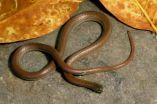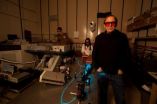Hemodynamic responses to the mother's face in infants by near-infrared spectroscopy
2010-12-17
(Press-News.org) A Japanese research group led by Prof. Ryusuke Kakigi and Dr. Emi Nakato (National Institute for Physiological Sciences: NIPS) and Prof. Masami K Yamaguchi (Chuo University) found that there was the different hemodynamic response in the temporal cortex between infants' perceptions of their own mother and of female strangers. The presentation of mother's face elicited increased hemodynamic responses in the bilateral temporal cortex. This finding was reported in Early Human Development.
Recognition of the mother's face is important in the development of an infant's social communication. In this study, the research group investigated 7- and 8-month-old infants' brain activity during the perception of the mother's face and strangers' faces by near-infrared spectroscopy (NIRS). NIRS is a non-invasive technique which estimates cerebral blood flow in the human brain and can assess changes in the concentration of oxyhemoglobin (oxy-Hb), deoxyhemoglobin (deoxy-Hb), and total hemoglobin (total-Hb) as an index of neural activity.
The finding was that the oxy- and the total-Hb concentrations in both the right and left temporal cortices were significantly increased for the mother's face. By contrast, significant increases in the oxy- and the total-Hb concentration were observed in the right temporal cortex for strangers' faces. The great activity in the right temporal cortex for faces irrespective of familiarity was consistent with our previous NIRS data which showed the right temporal cortex were involved in perception of faces in infants. It is noteworthy that the greater hemodynamic response in the left temporal cortex was observed only for mother's face. This increased hemodynamic response implies the specific mechanism for the processing of the mother's face in infants' brain.
The research group said, "Our findings imply that the probable presence of cortical specialization for the mother's face in infants may be firmly established by the age of 7 to 8 months. This is the first study to clarify the location of brain activity in infants related to the perception of their mother's face."
INFORMATION: END
ELSE PRESS RELEASES FROM THIS DATE:
2010-12-17
Global biodiversity surveys over the past few years have provided increasing evidence that our planet is in the midst of its sixth mass extinction. Plants, animals, and microorganisms are disappearing thousands of times more rapidly than they have for more than 65 million years, and for the first time in Earth's history, human activity is the predominant force behind this mass extinction. As governments and conservation organizations around the world attempt to stem this tide of disappearing species, they face a number of formidable challenges, but perhaps the greatest ...
2010-12-17
An infrequently used blood test can effectively identify individuals at increased risk of developing complications associated with chronic kidney disease (CKD), according to a study appearing in an upcoming issue of the Journal of the American Society Nephrology (JASN). Use of this simple test might help physicians identify persons with CKD who are at high risk for complications, and identify persons with impaired kidney function at earlier stages of disease.
To assess kidney function, doctors most often measure an individual's level of creatinine in the blood. Creatinine ...
2010-12-17
Researchers at the University of Iowa have pinpointed the part of the brain that causes people to experience fear – a discovery that could improve treatment of post-traumatic stress disorder (PTSD) and other anxiety conditions.
Published today in the journal Current Biology, the study investigates how the emotion of fear depends on an almond-shaped brain region called the amygdala. The patient in the case study has a rare condition that destroyed her amygdala. UI researchers observed the patient's response to frightening stimuli such as a haunted house, snakes, spiders, ...
2010-12-17
The finding offers a powerful take on the connection between the brain and behavior, specifically in the context of situations that would normally evoke fear, the researchers say.
"The nature of fear is survival and the amygdala helps us stay alive by avoiding situations, people, or objects that put our life in danger," said Justin Feinstein of the University of Iowa. "Because SM is missing her amygdala, she is also missing the ability to detect and avoid danger in the world. It is quite remarkable that she is still alive."
Feinstein says that the average person may ...
2010-12-17
Naturally occurring high hemoglobin levels are safe for kidney disease patients on dialysis, according to a study appearing in an upcoming issue of the Journal of the American Society Nephrology (JASN). The results suggest that there is no need to lower these levels to protect patients' health.
The vast majority of individuals who develop advanced chronic kidney disease (CKD) also develop progressive anemia, or red blood cell deficiency, that must be treated with medication. Prior to the approval of such erythropoiesis-stimulating agents in 1989, many dialysis patients ...
2010-12-17
Cystatin C, a blood marker of kidney function, proved significantly more accurate than the standard blood marker, creatinine, in predicting serious complications of kidney disease, in a study by researchers at the San Francisco VA Medical Center and the University of California, San Francisco.
Among adults who were identified as having chronic kidney disease by high creatinine levels, the researchers found that only patients who also had abnormally high levels of cystatin C were at high risk for death, cardiovascular disease, heart failure, or kidney failure. People with ...
2010-12-17
A new study provides fascinating insight into the underlying pathology associated with the autoimmune disease, systemic lupus erythematosus (SLE). The research, published by Cell Press in the December issue of the journal Immunity, reveals an unexpected role for a key type of immune cell and provides a potential new therapeutic strategy for SLE and, potentially, other autoimmune diseases.
SLE is a chronic systemic disease that can affect many regions of the body and, as a result, presents with diverse clinical symptoms. As is characteristic of other autoimmune disease, ...
2010-12-17
Until this year, all human-made objects have moved according to the laws of classical mechanics. Back in March, however, a group of researchers designed a gadget that moves in ways that can only be described by quantum mechanics—the set of rules that governs the behavior of tiny things like molecules, atoms, and subatomic particles. In recognition of the conceptual ground their experiment breaks, the ingenuity behind it and its many potential applications, Science has called this discovery the most significant scientific advance of 2010.
Physicists Andrew Cleland and ...
2010-12-17
SALT LAKE CITY, Dec. 16, 2010 – University of Utah physicists stored information for 112 seconds in what may become the world's tiniest computer memory: magnetic "spins" in the centers or nuclei of atoms. Then the physicists retrieved and read the data electronically – a big step toward using the new kind of memory for both faster conventional and superfast "quantum" computers.
"The length of spin memory we observed is more than adequate to create memories for computers," says Christoph Boehme (pronounced Boo-meh), an associate professor ...
2010-12-17
The greater susceptibility of humans to certain infectious diseases when compared to other primates could be explained by species-specific changes in immune signaling pathways, a University of Chicago study finds. The first genome-wide, functional comparison of genes regulated by the innate immune system in three primate species discovers potential mediators of differences in disease susceptibility among primates. These findings are published on December 16 in the open-access journal PLoS Genetics.
Humans are more sensitive than chimpanzees to the severe effects of certain ...
LAST 30 PRESS RELEASES:
[Press-News.org] Hemodynamic responses to the mother's face in infants by near-infrared spectroscopy

